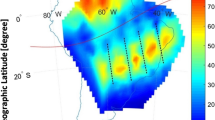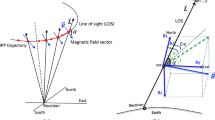Abstract
In this work, the climatology of ionospheric scintillations at global positioning system (GPS) L-band frequency and the zonal drift velocities of scintillation-producing irregularities were depicted for the equatorial observatory of São Luis (2.33°S; 44.21°W; dip latitude 1.3°S), Brazil. This is the first time that the hourly, monthly, and seasonal variations of scintillations and irregularity zonal drifts at São Luis were characterized during periods of different solar activity levels (from December 1998 to February 2007). The percentage occurrence of scintillations at different sectors of the sky was also investigated, and the results revealed that the scintillations are more probable to be observed in the west sector of the sky above São Luis, whereas the north–south asymmetries are possibly related to asymmetries in the plasma density distribution at off-equatorial latitudes. The scintillations on GPS signals occurred more frequently around solar maximum years, but it is also clear from the results of a strong variability in the scintillation activity in the years with moderate solar flux during the descending phase of the solar cycle. The equatorial scintillations occur predominantly during pre-midnight hours with a broad maximum near the December solstice months. In general, weak level of scintillations (S 4 index between 0.2 and 0.4) dominated at all seasons; however, during the winter months around solar maximum years (although the scintillation occurrence is extremely low), stronger levels of scintillations (S 4 > 0.6) may occur at comparable rate with the weak scintillations. The irregularity zonal velocities, as estimated from the GPS spaced-receiver technique, presented a different scenario for the two seasons analyzed; during the equinoxes, the magnitude of the zonal velocities appeared not to change with the solar activity, whereas during the December solstice months, the larger magnitudes were observed around solar maximum years. Other relevant aspects of the observations are highlighted and discussed.









Similar content being viewed by others
References
Abdu MA, Sobral JHA, Batista IS, Rios VH, Medina C (1998) Equatorial spread-F occurrence statistics in the American longitudes: diurnal, seasonal and solar cycle variations. Adv Space Res 22:851–854
Akala AO, Doherty PH, Valladares CE, Carrano CS, Sheehan R (2011) Statistics of GPS scintillation over South America at three levels of solar activity. Radio Sci. doi:10.1029/2011RS004678
Alex S, Koparkar PV, Rastogi RG (1989) Spread-F and ionization anomaly belt. J Atmos Terr Phys 51:371–379
Bartels J (1963) Discussion of time variations of geomagnetic activity indices Kp and Ap 1932–1961. Ann Geophys 19:1–20
Beach TL (1998) Global positioning system studies of equatorial scintillations. PhD thesis, Cornell University
Beach TL, Kintner PM (2001) Development and use of a GPS ionospheric scintillation monitor. IEEE Trans Geosci Remote Sens 39:918–928
Bhattacharyya A, Basu S, Groves KM, Valladares CE, Sheehan R (2001) Dynamics of equatorial F region irregularities from spaced receiver scintillation observations. Geophys Res Lett 28:119–122
Bittencourt JA, Pillat VG, Fagundes PR, Sahai Y, Pimenta AA (2007) LION: a dynamic computer model for the low-latitude ionosphere. Ann Geophys 25:2371–2392
Briggs BH, Phillips GJ, Shinn DH (1950) The analysis of observations on spaced receivers of the fading of radio signals. Proc Phys Soc Sect B 63:106–121
Burke WJ, Gentile LC, Huang CY, Valladares CE, Su SY (2004) Longitudinal variability of equatorial plasma bubbles observed by DMSP and ROCSAT-1. J Geophys Res. doi:10.1029/2004JA010583
Costa E, de Paula ER, Rezende LFC, Groves KM, Roddy PA (2011) Equatorial scintillation predictions from C/NOFS Planar Langmuir Probe electron density fluctuation data. In: Proceedings of the XXX URSI general assembly scientific symposium, vol 1, pp G.05.2.1–G.05.2.4
de Paula ER, Kherani EA, Abdu MA, Batista IS, Sobral JHA, Kantor IJ, Takahashi H, Rezende LFC, Muella MTAH, Rodrigues FS, Kintner PM, Ledvina BM, Mitchell CN, Groves KM (2007) Characteristics of the ionospheric irregularities over Brazilian longitudinal sector. Indian J Radio Space Phys 36:268–277
de Paula ER, Muella MTAH, Sobral JHA, Abdu MA, Batista IS, Beach TL, Groves KM (2010) Magnetic conjugate point observations of kilometer and hundred-meter scale irregularities and zonal drifts. J Geophys Res. doi:10.1029/2010JA015383
Ezquer RG, Kintner PM, Cabrera MA, Radicella SM, Forte B (2003) Scintillations observed at Tucuman as observed from GPS signals: first results. Adv Space Res 31:741–747
Fejer BG, Scherliess L, de Paula ER (1999) Effects of vertical plasma drift velocities on the generation and evolution of equatorial spread-F. J Geophys Res 104:19859–19869
Fesen CG, Crowley G, Roble RG, Richmond AD, Fejer BG (2000) Simulation of the pre-reversal enhancement in the low latitude vertical ion drifts. Geophys Res Lett. doi:10.1029/2000GL000061
Haerendel G (1973) Theory of equatorial spread F. Report, Maxplanck-Institut fur Extraterre. Phys. Garching, Germany
Finlay CC et al (2010) International geomagnetic reference field: the eleventh generation. Geophys J Int. doi:10.1111/j.1365-246X.2010.04804.x
Haerendel G, Eccles JV, Çakir S (1992) Theory of modeling the equatorial evening ionosphere and the origin of the shear in the horizontal plasma flow. J Geophys Res 97:1209–1223
Huang CS, de La Beaujardiere O, Pfaff RF, Retterer JM, Roddy PA, Hunton DE, Su YJ, Su SY, Rich FJ (2010) Zonal drift of plasma particles inside equatorial plasma bubbles and its relation to the zonal drift of the bubble structure. J Geophys Res. doi:10.1029/2010JA015324
Iyer KN, Jivani MN, Abdu MA, Joshi HP, Aggarwal M (2006) Power spectral studies of VHF ionospheric scintillations near the crest of the equatorial anomaly in India. Indian J Radio Space Phys 35:234–241
Kil K, Kintner PM, de Paula ER, Kantor IJ (2000) Global positioning system measurements of the ionospheric zonal apparent velocity at Cachoeira Paulista in Brazil. J Geophys Res 105:5317–5327
Kil H, Kintner PM, de Paula ER, Kantor IJ (2002) Latitudinal variations of scintillation activity and zonal plasma drifts in South America. Radio Sci. doi:10.1029/2001RS002468
Kil H, DeMajistre R, Paxton LJ, Zhang Y (2006) Nighttime F-region morphology in the low and middle latitudes seen from DMSP F15 and TIMED/GUVI. J Atmos Solar Terr Phys 68:1672–1681
Kintner PM, Ledvina BM (2005) The ionosphere, radio navigation, and global navigation satellite systems. Adv Space Res 35:788–811
Kintner PM, Kil H, Beach TL, de Paula ER (2001) Fading timescales associated with GPS signals and potential consequences. Radio Sci 36:731–743
Kintner PM, Ledvina BM, de Paula ER, Kantor IJ (2004) Size, shape, orientation, speed, and duration of GPS equatorial anomaly scintillations. Radio Sci. doi:10.1029/2003RS002878
Kintner PM, Ledvina BM, de Paula ER (2007) GPS and ionospheric scintillations. Space Weather. doi:10.1029/2006SW000260
Ledvina BM, Kintner PM, de Paula ER (2004) Understanding spaced-receiver zonal velocity estimation. J Geophys Res. doi:10.1029/2004JA010489
Muella MTAH, de Paula ER, Kantor IJ, Rezende LFC, Smorigo PF (2009) Occurrence and zonal drifts of small-scale ionospheric irregularities over an equatorial station during solar maximum—magnetic quiet and disturbed conditions. Adv Space Res 43:1957–1973
Muella MTAH, Kherani EA, de Paula ER, Cerruti AP, Kintner PM, Kantor IJ, Mitchell CN, Batista IS, Abdu MA (2010a) Scintillation-producing Fresnel-scale irregularities associated with the regions of steepest TEC gradients adjacent to the equatorial ionization anomaly. J Geophys Res. doi:10.1029/2009JA014788
Muella MTAH, de Paula ER, Fagundes PR, Bittencourt JA, Sahai Y (2010b) Thermospheric meridional wind control on equatorial scintillations and the role of the evening F-region height rise, E × B drift velocities and F2-peak density gradients. Surv Geophys 31:509–530. doi:10.1007/s10712-010-9101-3
Muella MTAH, de Paula ER, Monteiro AA (2013) Ionospheric scintillation and dynamics of Fresnel-scale irregularities in the inner region of the equatorial ionization anomaly. Surv Geophys 34:233–251. doi:10.1007/s10712-012-9212-0
Otsuka Y, Shiokawa K, Ogawa T (2006) Equatorial ionospheric scintillations and zonal irregularity drifts observed with closely-spaced GPS receivers in Indonesia. J Meteorol Soc Jpn 84:343–351
Rezende LFC, de Paula ER, Stephany S, Kantor IJ, Muella MTAH, de Siqueira PM, Correa KS (2010) Survey and prediction of the ionospheric scintillation using data mining techniques. Space Weather. doi:10.1029/2009SW000532
Rodrigues FS (2003) Estudo das irregularidades ionosfericas equatoriais utilizando sinais GPS. Master dissertation, INPE
Saito S, Maruyama T, Ishii M, Kubota M, Ma G, Chen Y, Li J, Duyen CH, Truong TL (2008) Observations of small- to large-scale ionospheric irregularities associated with plasma bubbles with a transequatorial HF propagation experiment and spaced GPS receivers. J Geophys Res. doi:10.1029/2008JA013149
Shang SP, Shi JK, Kintner PM, Zhen WM, Luo XG, Wu SZ, Wang GJ (2008) Response of Hainan GPS ionospheric scintillations to the different strong magnetic storm conditions. Adv Space Res 41:579–586
Sobral JHA, Abdu MA, Pedersen TR, Castilho VM, Arruda DCS, Muella MTAH, Batista IS, Mascarenhas M, de Paula ER, Kintner PM, Kherani EA, Medeiros AF, Buriti RA, Takahashi H, Schuch NJ, Denardini CM, Zamlutti CJ, Pimenta AA, de Souza JR, Bertoni FCP (2009) Ionospheric zonal velocities at conjugate points over Brazil during the COPEX campaign: experimental observations and theoretical validations. J Geophys Res. doi:10.1029/2008JA013896
Van Dierendonck AJ (1996) GPS Receivers. In: Parkinson B, Spilker JJ Jr (eds) Global positioning system: theory and applications, vol. I. American Institute of Aeronautics and Astronautics, Washington, DC
Acknowledgments
This work was partially supported by Fundação de Amparo à Pesquisa do Estado de São Paulo (FAPESP) under Processes No. 2012/06598-2 and 2008/04892-5, by Coordenação de Aperfeiçoamento de Pessoal de Nível Superior (CAPES) under Process No. AEX9761/11-0, and Conselho Nacional de Desenvolvimento Científico e Tecnológico (CNPq) under Grant No. 308017/2011-0.
Author information
Authors and Affiliations
Corresponding author
Rights and permissions
About this article
Cite this article
Muella, M.T.A.H., de Paula, E.R. & Jonah, O.F. GPS L1-Frequency Observations of Equatorial Scintillations and Irregularity Zonal Velocities. Surv Geophys 35, 335–357 (2014). https://doi.org/10.1007/s10712-013-9252-0
Received:
Accepted:
Published:
Issue Date:
DOI: https://doi.org/10.1007/s10712-013-9252-0




